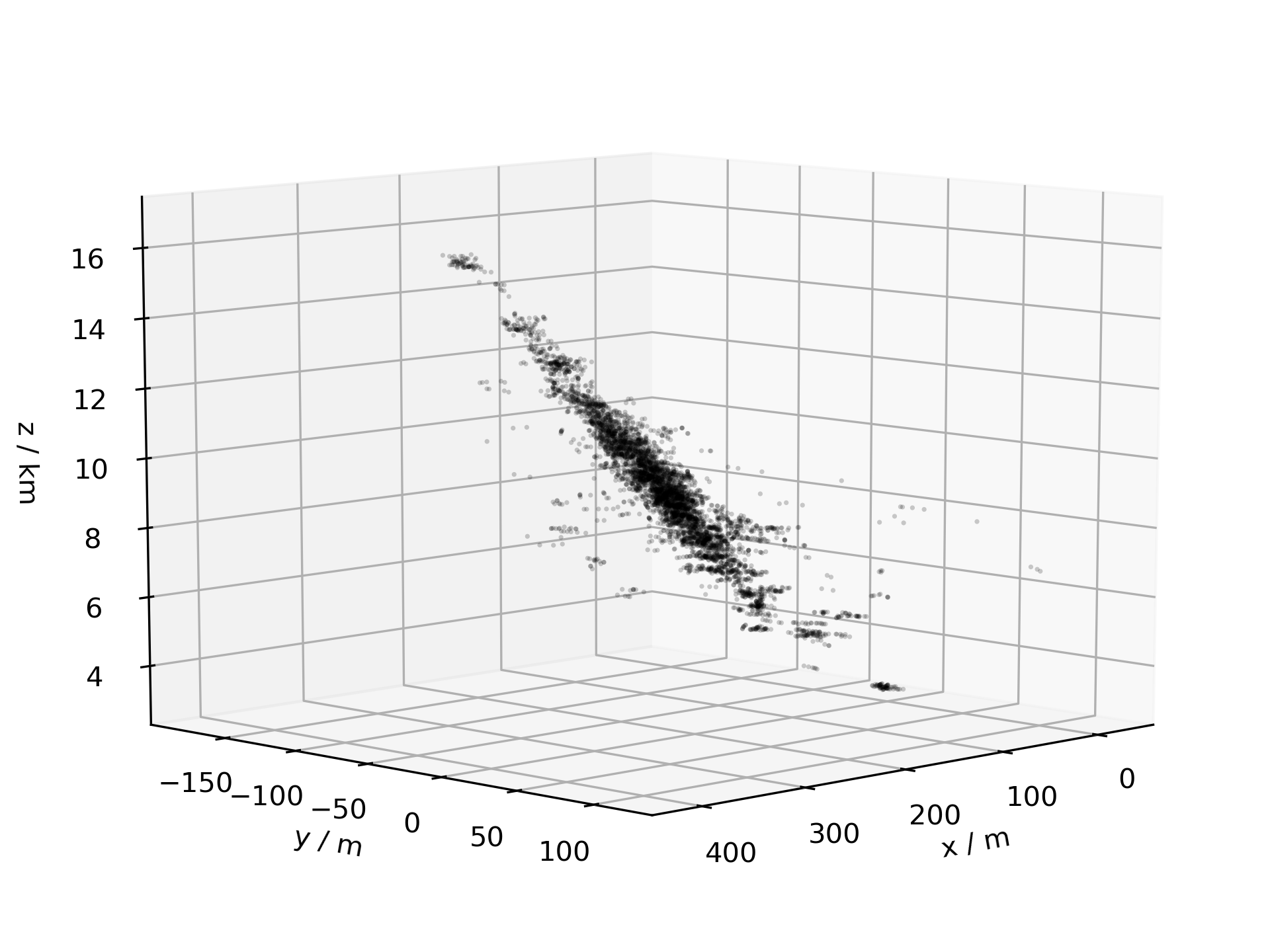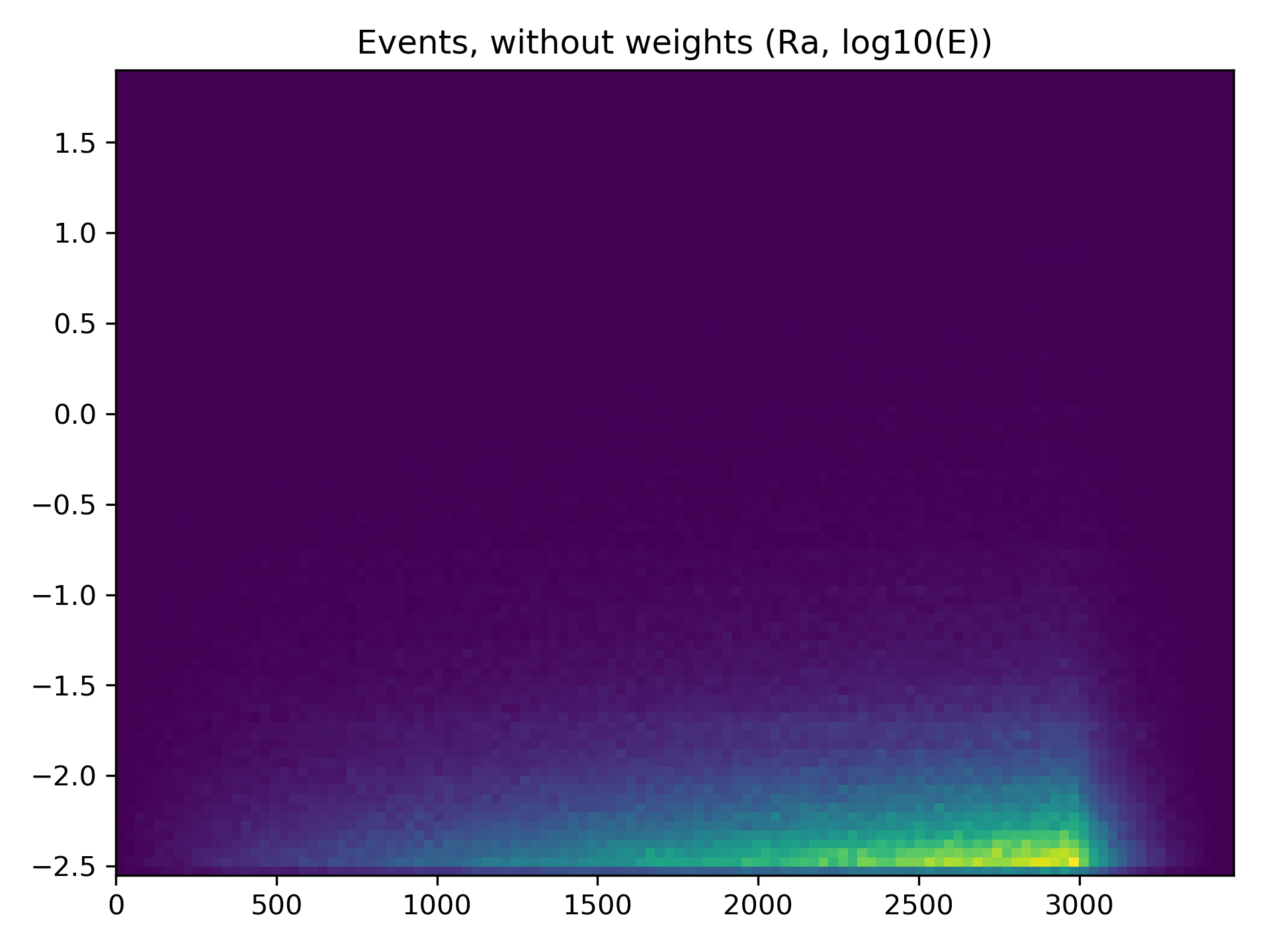Python read-only implementation of the EventIO file format
Project description
A Python (read-only) implementation of the EventIO data format invented by Konrad Bernloehr as used for example by the IACT extension for CORSIKA: https://www.ikp.kit.edu/corsika
Documentation of the file format: https://www.mpi-hd.mpg.de/hfm/~bernlohr/sim_telarray/Documentation/eventio_en.pdf
Most blocks of the IACT extension and SimTel are implemented. The following blocks are known, but reading their data is not (yet) implemented:
Code |
Description |
|---|---|
1206 |
IACT Layout |
1207 |
IACT Trigger Time |
2017 |
SimTel PixelCalib |
2024 |
SimTel RunStat |
2025 |
SimTel MC_RunStat |
2028 |
SimTel CalibEvent |
install with
pip install eventio
Open a file produced by the IACT CORSIKA extension
First Example
One may iterate over an instance of IACTFile class in order to retrieve events. Events have a small number of fields. The most important one is the photon_bunches field, which is dictionary mapping telescope ids to a simple structured np.array, containing the typical parameters Cherenkov photon bunches in CORSIKA have, like:
x, y coordinate in the observation plane (in cm)
direction cosine cx, cy in x and y direction of the incident angle of the photon
wavelength lambda of the photon (in nm)
number of photons associated with this bunch
the time since the first interaction (in ns, I believe)
the production height of the photon bunch (called zem)
a bool flag, whether the photon was scattered in the atmosphere
An event has the following attributes: * header: a namedtuple containing the Corsika Event Header data * end_block: a numpy array containing the Corsika Event End data * time_offset, x_offset, y_offsett, the offset of the array
This prints energy and the number of photons for the first telescope in every event:
import eventio
with eventio.IACTFile('eventio/resources/one_shower.dat') as f:
for event in f:
print(event.header.total_energy)
print(event.photon_bunches[0]['photons'].sum())Second Example
If you like to plot the origin of the Cherenkov photons of the first event in file eventio/resources/one_shower.data for the first telescope, have a look into this example
It might look similar to this picture:

an example shower
Open a file produced by simtel_array
import eventio
with eventio.SimTelFile('eventio/resources/gamma_test.simtel.gz') as f:
print(len(f.telescope_descriptions))
for array_event in f:
print(array_event['mc_shower']['energy'])Commandline Tools
We provide three commandline tools, to look into eventio files.
To get an overview over the structure of a file, use eventio_print_structure, for larger files, you might want to pipe its output into e.g. less:
$ eventio_print_structure eventio/resources/gamma_test.simtel.gz
History[70](size=11960, only_subobjects=True, first_byte=16)
HistoryCommandLine[71](size=668, only_subobjects=False, first_byte=12)
HistoryConfig[72](size=120, only_subobjects=False, first_byte=692)
HistoryConfig[72](size=172, only_subobjects=False, first_byte=824)
HistoryConfig[72](size=180, only_subobjects=False, first_byte=1008)
HistoryConfig[72](size=176, only_subobjects=False, first_byte=1200)
HistoryConfig[72](size=72, only_subobjects=False, first_byte=1388)
And 124 objects more of the same type
.
.
.To get table of all object versions and counts in a file, use eventio_print_object_information, it can also print json if given the --json option
$ eventio_print_object_information eventio/resources/gamma_test.simtel.gz
Type | Version | #Objects
--------------------------
70 | 1 | 3
71 | 1 | 3
72 | 1 | 32840
1212 | 0 | 2
2000 | 2 | 1
2001 | 4 | 2
2002 | 2 | 98
2002 | 3 | 28
2003 | 1 | 126
2004 | 2 | 126
2005 | 0 | 126
2006 | 0 | 126
2007 | 0 | 126
2008 | 0 | 126
2009 | 2 | 10
.
.
.To plot histograms stored in an eventio file (Type 100), use eventio_plot_histograms.
$ eventio_plot_histograms gamma_20deg_180deg_run99___cta-prod3_desert-2150m-Paranal-merged_cone10.simtel.gz
Histogram of Impact distance vs log10(E / TeV)
Low level access
For more low level access to the items of an EventIO file (or to implement a higher level abstraction like IACTFile) one can use the EventIOFile class which gives access to the objects and subobjects in EventIO files.
This is how our test file looks like in the low level view:
In [3]: with EventIOFile('eventio/resources/one_shower.dat') as f:
...: for obj in f:
...: print(obj)
...: if obj.header.only_subobjects:
...: for subobj in obj:
...: print(' ', subobj)
CORSIKARunHeader[1200](size=1096, only_subobjects=False, first_byte=16)
CORSIKAInputCard[1212](size=448, only_subobjects=False, first_byte=1128)
CORSIKATelescopeDefinition[1201](size=20, only_subobjects=False, first_byte=1592)
CORSIKAEventHeader[1202](size=1096, only_subobjects=False, first_byte=1628)
CORSIKAArrayOffsets[1203](size=16, only_subobjects=False, first_byte=2740)
CORSIKATelescopeData[1204](size=6136, only_subobjects=True, first_byte=2772)
IACTPhotons(length=6124, n_bunches=382)
CORSIKAEventEndBlock[1209](size=1096, only_subobjects=False, first_byte=8924)
CORSIKARunEndBlock[1210](size=16, only_subobjects=False, first_byte=10036)
Project details
Release history Release notifications | RSS feed
Download files
Download the file for your platform. If you're not sure which to choose, learn more about installing packages.












